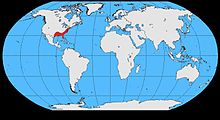Fish crow
| Fish crow | |
|---|---|
 |
|
| Scientific classification | |
| Kingdom: | Animalia |
| Phylum: | Chordata |
| Class: | Aves |
| Order: | Passeriformes |
| Family: | Corvidae |
| Genus: | Corvus |
| Species: | C. ossifragus |
| Binomial name | |
|
Corvus ossifragus Wilson, 1812 |
|
 |
|
| Fish crow range | |
The fish crow (Corvus ossifragus) is a species of crow associated with wetland habitats in the eastern and southeastern United States.
The fish crow was first described by Alexander Wilson in 1812. The latest genetic testing now seems to indicate this species is close to the Sinaloan crow (C. sinaloae) and the Tamaulipas crow (C. imparatus), and not as close to the American crow (C. brachyrhynchos) as outward signs would suggest.
The fish crow is superficially similar to the American crow, but is smaller (36–41 cm in length) and has a more silky smooth plumage by comparison. The upperparts have a blue or blue-green sheen, while the underparts have a more greenish tint to the black. The eyes are dark brown. The differences are often only really apparent between the two species when seen side by side or when heard calling. The bill is usually somewhat slimmer than the American crow, but is only readily distinguishable if both species are seen together.
Visual differentiation from the American crow is extremely difficult and often inaccurate. Nonetheless, differences apart from size do exist. Fish crows tend to have more slender bills and feet. There may also be a small sharp hook at the end of the upper bill. Fish crows also appear as if they have shorter legs when walking. More dramatically, when calling, fish crows tend to hunch and fluff their throat feathers.
The voice is the most outwardly differing characteristic for this species and other American crow species. The call of the fish crow has been described as a nasal "ark-ark-ark" or a begging "waw-waw". Birders often distinguish the two species (in areas where their range overlaps) with the mnemonic aid "Just ask him if he is an American crow. If he says "no", he is a fish crow." referring to the fact that the most common call of the American crow is a distinct "caw caw", while that of the fish crow is a nasal "nyuh unh".
This species occurs on the eastern seaboard of the United States from Rhode Island south to Key West, and west along the northern coastline of the Gulf of Mexico and follows many river systems inland for quite some distance. Coastal marshes and beaches, rivers, inland lakes and marshes, river banks, and the land immediately surrounding all are frequented.
...
Wikipedia

